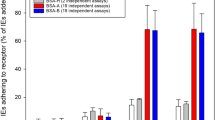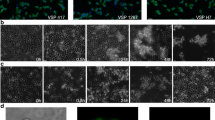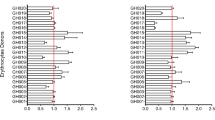Abstract
ADHESION of parasitized erythrocytes to post-capillary venular endothelium1or uninfected red cells'2–4 is strongly implicated in the pathogenesis of severe Plasmodlum faldparum malaria. Neo-antigens at the infected red-cell surface adhere to a variety of host receptors5–9, demonstrate serological diversity in field isolates10,11 and may also be a target of the host-protective immune response12. Here we use sequential cloning ofP. faldparum by micromanipula-tion to investigate the ability of a parasite to switch antigenic and cytoadherence phenotypes. Our data show that antigens at the parasitized cell surface undergo clonal variation in vitro in the absence of immune pressure at the rate of 2% per generation with concomitant modulations of the adhesive phenotype. A clone has the potential to switch at high frequency to a variety of antigenic and adhesive phenotypes, including a new type of cytoadherence behaviour, 'auto-agglutination' of infected erythrocytes. This rapid appearance of antigenic and functional heterogeneity has important implications for pathogenesis and acquired immunity.
This is a preview of subscription content, access via your institution
Access options
Subscribe to this journal
Receive 51 print issues and online access
$199.00 per year
only $3.90 per issue
Buy this article
- Purchase on Springer Link
- Instant access to full article PDF
Prices may be subject to local taxes which are calculated during checkout
Similar content being viewed by others
References
MacPherson, G. G., Warrell, M. J., White, N. J., Looareesuran, S. & Warrell, D. A. Am. J. Path. 119, 385–401 (1985).
David, P. H., Handunetti, S. M., Leech, J. H., Gamage, P. & Mendis, K. M. Am. J. trop. Med. Hyg. 38, 289–297 (1988).
Udomsangpetch, R. et al. J. exp. Med. 169, 1835–1840 (1989).
Carlson, J. et al. Lancet 336, 1457–1460 (1990).
Barnwell, J. W. et al. J. clin. Invest. 84, 765–772 (1989).
Ockenhouse, C. F., Tandon, N. N., Magowan, C., Jamieson, G. A. & Chulay, J. D. Science 243, 1469–1471 (1989).
Oquendo, P., Hundt, E., Lawler, J. & Seed, B. Cell 58, 95–101 (1989).
Roberts, D. D. et al. Nature 318, 64–66 (1985).
Berendt, A. R., Simmons, D. L., Tansey, J., Newbold, C. I. & Marsh, K. Nature 341, 57–59 (1989).
Marsh, K. & Howard, R. J. Science 231, 150–153 (1986).
Forsyth, K. P. et al. Am. J. trop. Med. Hyg. 41, 259–267 (1989).
Marsh, K., Otoo, L., Hayes, R. J., Carson, D. C. & Greenwood, B. M. Trans. R. Soc. trop. Med. 83, 293–303 (1989).
Sinnis, P. & Wellems, T. E. Genomics 3, 287–295 (1988).
Turner, C. M. R. & Barry, J. D. Parasitology 99, 67–75 (1989).
Borst, P. & Greaves, D. R. Science 235, 658–667 (1987).
Brown, K. N. & Brown, I. N. Nature 208, 1286–1288 (1965).
Barnwell, J. R., Howard, R. J., Coon, H. G. & Miller, L. H. Infect. Immun. 40, 985–994 (1983).
McLean, S. A., Pearson, C. D. & Phillips, R. S. Expl Parasitol. 54, 296–302 (1986).
Handunnetti, S. M., Mendis, K. N. & David, P. D. J. exp. Med. 165, 1269–1283 (1987).
Gilks, C. F., Walliker, D. & Newbold, C. I. Parasite Immun. 12, 45–64 (1990).
Biggs, B. A. et al. Proc. natn. Acad. Sci. U.S.A. 88, 9171–9174 (1991).
Baird, J. K. et al. Am. J. trop. Med. Hyg. 45, 65–76 (1991).
Leech, J. H., Barnwell, J. W., Miller, L. H. & Howard, R. J. J. exp. Med. 159, 1567–1575 (1984).
Magowan, C., Woolish, W., Anderson, L. & Leech, J. J. exp. Med. 168, 1307–1319 (1988).
Trager, W. & Jensen, J. B. Science 193, 673–675 (1976).
Haynes, J. D., Diggs, C. L., Hines, F. A. & Desjardins, R. E. Nature 263, 767–769 (1976).
Jensen, J. B. Am. J. trop. Med. Hyg. 27, 1274–1280 (1978).
Tandon, N. N., Lipsky, R. H., Burgess, W. H. & Jamieson, G. A. J. biol. Chem. 264, 7570–7575 (1989).
Berendt, A. R. et al. Cell 68, 71–81 (1992).
Biggs, B. A. et al. J. Immun. (in the press).
Author information
Authors and Affiliations
Rights and permissions
About this article
Cite this article
Roberts, D., Craig, Berendt, A. et al. Rapid switching to multiple antigenic and adhesive phenotypes in malaria. Nature 357, 689–692 (1992). https://doi.org/10.1038/357689a0
Received:
Accepted:
Issue Date:
DOI: https://doi.org/10.1038/357689a0
This article is cited by
-
Selective expression of variant surface antigens enables Plasmodium falciparum to evade immune clearance in vivo
Nature Communications (2022)
-
Stochastic expression of invasion genes in Plasmodium falciparum schizonts
Nature Communications (2022)
-
IgG acquisition against PfEMP1 PF11_0521 domain cassette DC13, DBLβ3_D4 domain, and peptides located within these constructs in children with cerebral malaria
Scientific Reports (2021)
-
Plasmodium falciparum transcription in different clinical presentations of malaria associates with circulation time of infected erythrocytes
Nature Communications (2021)
-
Immunization with virus-like particles conjugated to CIDRα1 domain of Plasmodium falciparum erythrocyte membrane protein 1 induces inhibitory antibodies
Malaria Journal (2020)
Comments
By submitting a comment you agree to abide by our Terms and Community Guidelines. If you find something abusive or that does not comply with our terms or guidelines please flag it as inappropriate.



